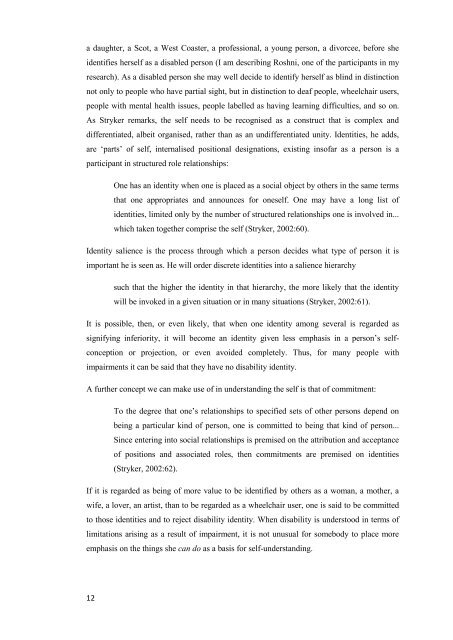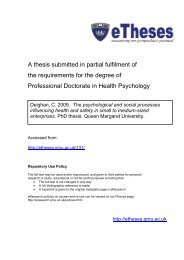A thesis submitted in partial fulfilment of - Etheses - Queen Margaret ...
A thesis submitted in partial fulfilment of - Etheses - Queen Margaret ...
A thesis submitted in partial fulfilment of - Etheses - Queen Margaret ...
Create successful ePaper yourself
Turn your PDF publications into a flip-book with our unique Google optimized e-Paper software.
a daughter, a Scot, a West Coaster, a pr<strong>of</strong>essional, a young person, a divorcee, before she<br />
identifies herself as a disabled person (I am describ<strong>in</strong>g Roshni, one <strong>of</strong> the participants <strong>in</strong> my<br />
research). As a disabled person she may well decide to identify herself as bl<strong>in</strong>d <strong>in</strong> dist<strong>in</strong>ction<br />
not only to people who have <strong>partial</strong> sight, but <strong>in</strong> dist<strong>in</strong>ction to deaf people, wheelchair users,<br />
people with mental health issues, people labelled as hav<strong>in</strong>g learn<strong>in</strong>g difficulties, and so on.<br />
As Stryker remarks, the self needs to be recognised as a construct that is complex and<br />
differentiated, albeit organised, rather than as an undifferentiated unity. Identities, he adds,<br />
are „parts‟ <strong>of</strong> self, <strong>in</strong>ternalised positional designations, exist<strong>in</strong>g <strong>in</strong>s<strong>of</strong>ar as a person is a<br />
participant <strong>in</strong> structured role relationships:<br />
12<br />
One has an identity when one is placed as a social object by others <strong>in</strong> the same terms<br />
that one appropriates and announces for oneself. One may have a long list <strong>of</strong><br />
identities, limited only by the number <strong>of</strong> structured relationships one is <strong>in</strong>volved <strong>in</strong>...<br />
which taken together comprise the self (Stryker, 2002:60).<br />
Identity salience is the process through which a person decides what type <strong>of</strong> person it is<br />
important he is seen as. He will order discrete identities <strong>in</strong>to a salience hierarchy<br />
such that the higher the identity <strong>in</strong> that hierarchy, the more likely that the identity<br />
will be <strong>in</strong>voked <strong>in</strong> a given situation or <strong>in</strong> many situations (Stryker, 2002:61).<br />
It is possible, then, or even likely, that when one identity among several is regarded as<br />
signify<strong>in</strong>g <strong>in</strong>feriority, it will become an identity given less emphasis <strong>in</strong> a person‟s self-<br />
conception or projection, or even avoided completely. Thus, for many people with<br />
impairments it can be said that they have no disability identity.<br />
A further concept we can make use <strong>of</strong> <strong>in</strong> understand<strong>in</strong>g the self is that <strong>of</strong> commitment:<br />
To the degree that one‟s relationships to specified sets <strong>of</strong> other persons depend on<br />
be<strong>in</strong>g a particular k<strong>in</strong>d <strong>of</strong> person, one is committed to be<strong>in</strong>g that k<strong>in</strong>d <strong>of</strong> person...<br />
S<strong>in</strong>ce enter<strong>in</strong>g <strong>in</strong>to social relationships is premised on the attribution and acceptance<br />
<strong>of</strong> positions and associated roles, then commitments are premised on identities<br />
(Stryker, 2002:62).<br />
If it is regarded as be<strong>in</strong>g <strong>of</strong> more value to be identified by others as a woman, a mother, a<br />
wife, a lover, an artist, than to be regarded as a wheelchair user, one is said to be committed<br />
to those identities and to reject disability identity. When disability is understood <strong>in</strong> terms <strong>of</strong><br />
limitations aris<strong>in</strong>g as a result <strong>of</strong> impairment, it is not unusual for somebody to place more<br />
emphasis on the th<strong>in</strong>gs she can do as a basis for self-understand<strong>in</strong>g.




